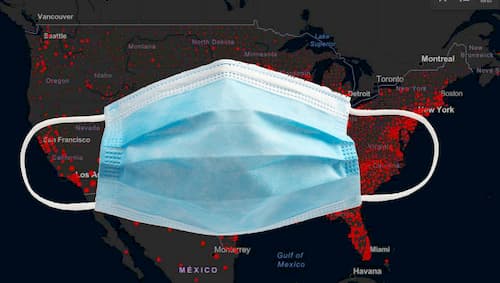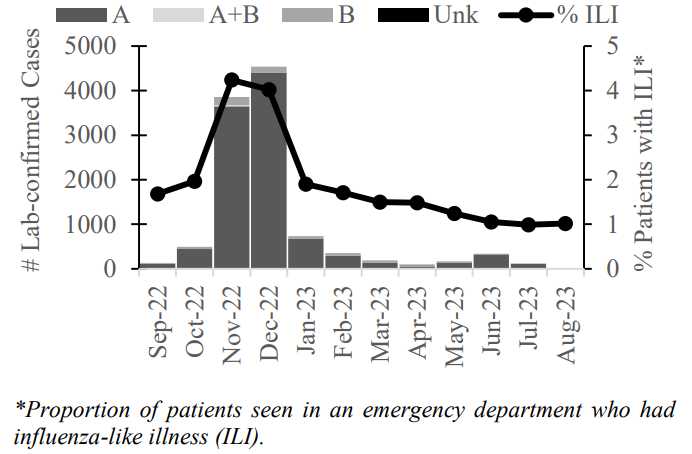Influenza activity is currently low in the United States as a whole, but is increasing in some parts of the country. This season, influenza A (H3N2) viruses have been reported most frequently and have been detected in almost all states.
During past seasons when influenza A (H3N2) viruses have predominated, higher overall and age-specific hospitalization rates and more mortality have been observed, especially among older people, very young children, and persons with certain chronic medical conditions compared with seasons during which influenza A (H1N1) or influenza B viruses have predominated.
Influenza viral characterization data indicates that 48% of the influenza A (H3N2) viruses collected and analyzed in the United States from October 1 through November 22, 2014 were antigenically “like” the 2014-2015 influenza A (H3N2) vaccine component, but that 52% were antigenically different (drifted) from the H3N2 vaccine virus. In past seasons during which predominant circulating influenza viruses have been antigenically drifted, decreased vaccine effectiveness has been observed. However, vaccination has been found to provide some protection against drifted viruses. Though reduced, this cross-protection might reduce the likelihood of severe outcomes such as hospitalization and death. In addition, vaccination will offer protection against circulating influenza strains that have not undergone significant antigenic drift from the vaccine viruses (such as influenza A (H1N1) and B viruses).
Because of the detection of these drifted influenza A (H3N2) viruses, this CDC Health Advisory is being issued to re-emphasize the importance of the use ofneuraminidase inhibitor antiviral medications when indicated for treatment and prevention of influenza, as an adjunct to vaccination.
The two prescription antiviral medications recommended for treatment or prevention of influenza are oseltamivir (Tamiflu®) and zanamivir (Relenza®).Evidence from past influenza seasons and the 2009 H1N1 pandemic has shown that treatment with neuraminidase inhibitors has clinical and public health benefit in reducing severe outcomes of influenza and, when indicated, should be initiated as soon as possible after illness onset. Clinical trials and observational data show that early antiviral treatment can:
- shorten the duration of fever and illness symptoms;
- reduce the risk of complications from influenza (e.g., otitis media in young children and pneumonia requiring antibiotics in adults); and
- reduce the risk of death among hospitalized patients.
Background
As of November 22, influenza activity has increased slightly in most parts of the United States. Surveillance data indicate that influenza A (H3N2) viruses have predominated so far, with lower levels of detection of influenza B viruses and even less detection of H1N1 viruses. During the week ending November 22, 1,123 (91.4%) of the 1,228 influenza-positive tests reported to CDC were influenza A viruses and 105 (8.6%) were influenza B viruses. Of the 85 influenza A (H3N2) viruses collected by U.S. laboratories and antigenically or genetically characterized at CDC since October 1, 2014, 44 (52%) are significantly different (drifted) from A/Texas/50/2012, the U.S. H3N2 vaccine virus. Drifted H3N2 viruses were first detected in late March 2014, after World Health Organization (WHO) recommendations for the 2014-2015 Northern Hemisphere vaccine had been made in mid-February. At that time, a very small number of these viruses had been found among the thousands of specimens that had been collected and tested, but these viruses have become more predominant over time. Most of the drifted H3N2 viruses are A/Switzerland/9715293/2013 viruses, which is the H3N2 virus selected for the 2015 Southern Hemisphere influenza vaccine. These drifted viruses will likely continue to circulate in the United States throughout the season. All influenza viruses tested for resistance to neuraminidase inhibitors this season have shown susceptibility to both oseltamivir and zanamivir. Given the likelihood that the drifted influenza A (H3N2) viruses will continue to circulate this season, CDC is issuing the following recommendations to remind clinicians of CDC’s guidance for the use of influenza antiviral medications.
Recommendations for Health Care Providers
Clinicians should encourage all patients 6 months and older who have not yet received an influenza vaccine this season to be vaccinated against influenza. There are several influenza vaccine options for the 2014-15 influenza season (seehttps://www.cdc.gov/flu/protect/vaccine/vaccines.htm).
Clinicians should encourage all persons with influenza-like illness who are at high risk for influenza complications (see list below) to seek care promptly to determine if treatment with influenza antiviral medications is warranted.
Summary of CDC Recommendations for Influenza Antiviral Medications for the 2014-2015 Season:
Influenza Vaccination
Clinicians should continue to vaccinate patients who have not yet received influenza vaccine this season.
Pages: 1 2






